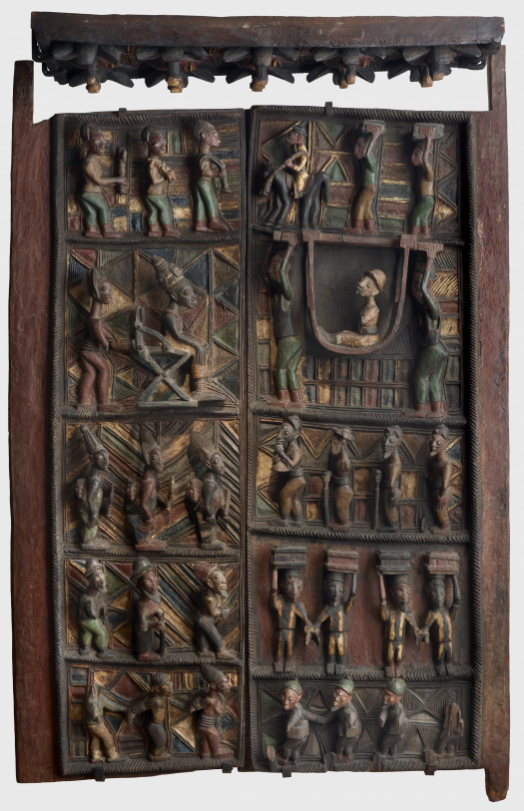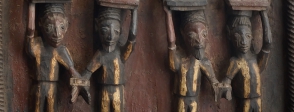
Indirect Rule in Nigeria
The British started to take control of the area known today as Nigeria in the 1880s, aiming to end the trafficking of slaves, bring Christianity to the region and trade commodities like palm oil and cocoa. The Protectorates of Southern and Northern Nigeria were established in 1900, and in 1914 were joined together to form one colony. Britain ruled Nigeria for 46 years before it gained independence as a nation in 1960. The British extended their control in stages by a mixture of diplomacy and military force. One method for asserting rule was to have a small number of British administrators operating through local leaders – a system depicted on these door panels and lintel. This form of administration became officially known as ‘Indirect Rule’ in 1912.
Commemorating an important first encounter
These doors were originally carved for the palace of the Ogoga (king) of Ikere to commemorate the moment around 1899/1901 when the Ogoga first received the British administrator, Captain Ambrose, into his palace. The right-hand panel shows the arrival of Ambrose, carried in a hammock. He is accompanied by Major Reeve-Tucker, his predecessor as travelling commissioner, who is shown on the upper register. You can also see soldiers, shackled prisoners and porters carrying boxes of cowrie shells, which have been collected as taxes. On the opposite panel, the Ogoga is seated on a throne, surrounded by his wives, children, palace officials and slaves. Above the door panels, the lintel shows vultures attacking the eyes of human faces. The panels were originally painted in many colours, only traces of which now survive.
An African perspective on the colonial experience
The carved doors offer us a picture of the administration of the British Empire in Nigeria as well as the local people’s perspective on the colonial experience. They were not just decorative. Such images shaped the perceptions of those who passed by as they went about their everyday activities.
As Southern and Northern Nigeria were firmly under British rule by the time the doors were made, the composition of the sculpture is intriguing. It could represent equal partnership between Britain and Nigeria, since Ambrose and the Ogoga on each panel mirror each other. It could suggest defiance against the increasing restrictions on local rulers’ power – illustrated by the regal pose adopted by the figure of the Ogoga in comparison with the seemingly humble expressions worn by Ambrose and his entourage.
On the lintel, the depiction of the human eyes being pecked by vultures represents human sacrifice – essential in the worship of Ogun, the patron saint of sculptors – which was outlawed by the British. This could be a warning to enemies, an honour to Ogun, or a sign of defiance towards the British by showing that such beliefs lingered.
More information
Introduction to Palace doors
Link to Explore on the British Museum website.
http://www.britishmuseum.org/explore/highlights/highlight_objects/aoa/p/pair_of_door_panels_and_a_lint.aspx
Teacher's notes
Link to teacher notes about Nigeria on the British Museum website.
http://www.britishmuseum.org/learning/schools_and_teachers/resources/all_resources-1/wealth_of_africa/colonial_rule_and_independence.aspx


